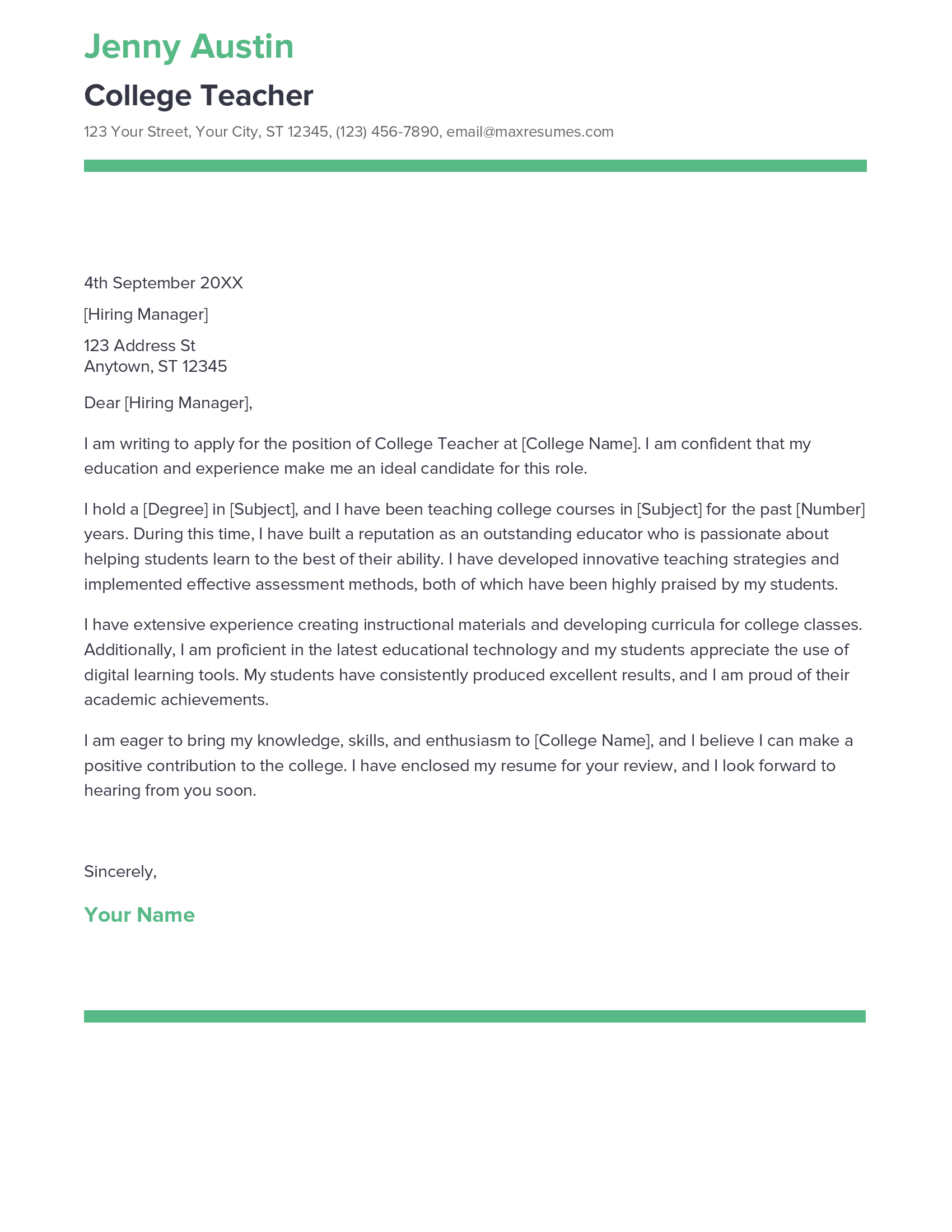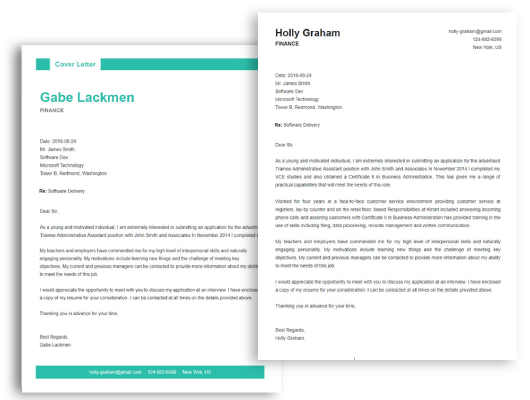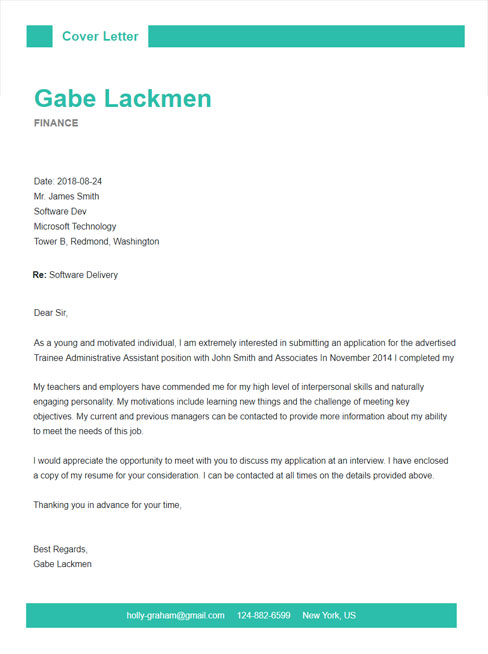- Resume Builder
- Resume Templates
- Resume Formats
- Resume Examples
- Cover Letter Builder
- Cover Letter Templates
- Cover Letter Formats
- Cover Letter Examples
- Career Advice
- Interview Questions
- Resume Skills
- Resume Objectives
- Job Description
- Job Responsibilities
- FAQ’s

College Teacher Cover Letter Example
Writing a cover letter for a college teaching position can be a challenging task. It requires you to succinctly summarize your qualifications and experience to demonstrate why you are best suited for the position. To help you, this guide provides a step-by-step approach for crafting a compelling cover letter to get your application noticed. We will also provide an example of a college teacher cover letter that you can use as a template for building your own. With these resources, you can confidently apply for the teaching opportunity you want.

Download the Cover Letter Sample in Word Document – Click Below
If you didn’t find what you were looking for, be sure to check out our complete library of cover letter examples .

Start building your dream career today!
Create your professional cover letter in just 5 minutes with our easy-to-use cover letter builder!
College Teacher Cover Letter Sample
Dear [Hiring Manager],
I am writing to apply for the position of College Teacher at [College Name]. I am confident that my education and experience make me an ideal candidate for this role.
I hold a [Degree] in [Subject], and I have been teaching college courses in [Subject] for the past [Number] years. During this time, I have built a reputation as an outstanding educator who is passionate about helping students learn to the best of their ability. I have developed innovative teaching strategies and implemented effective assessment methods, both of which have been highly praised by my students.
I have extensive experience creating instructional materials and developing curricula for college classes. Additionally, I am proficient in the latest educational technology and my students appreciate the use of digital learning tools. My students have consistently produced excellent results, and I am proud of their academic achievements.
I am eager to bring my knowledge, skills, and enthusiasm to [College Name], and I believe I can make a positive contribution to the college. I have enclosed my resume for your review, and I look forward to hearing from you soon.
Sincerely, [Your Name]
Create My Cover Letter
Build a profession cover letter in just minutes for free.
Looking to improve your resume? Our resume examples with writing guide and tips offers extensive assistance.
What should a College Teacher cover letter include?
A college teacher cover letter should be comprehensive and provide a succinct overview of the candidate’s qualifications, experience, and achievements. The cover letter should provide a clear statement of the position the candidate is applying for and what their goals are in applying for the position.
The cover letter should include information about the candidate’s education, professional experience, and any other relevant background. It should also include a brief summary of the candidate’s skills and qualifications, why they are interested in the position, and how their qualifications and experience make them a good fit for the position. Additionally, the cover letter should include any accolades or awards the candidate has received, as well as any professional development and community service activities the candidate may have participated in.
Finally, the cover letter should include a closing statement, thanking the recipient for their time and expressing the candidate’s interest in the position. This should be followed by contact information, such as an email address and/or telephone number, so the recipient can easily reach the candidate to set up an interview or discuss the application further.
College Teacher Cover Letter Writing Tips
Writing a college teacher cover letter can be a daunting task, especially when applying for your first teaching job. Fortunately, there are some helpful tips to keep in mind that can make the process a bit easier.
Here are some tips to consider when writing a college teacher cover letter:
- Highlight your qualifications: When writing a cover letter, it’s important to highlight your qualifications and show why you’re the best fit for the job. Be sure to mention any relevant experience, certifications, or qualifications that you have that make you a great fit for the position.
- Show your enthusiasm: A cover letter should convey your enthusiasm and excitement for the position. Be sure to show your passion for the job and what you can bring to the table.
- Tailor it to the job: Make sure to tailor your cover letter to the specific job and institution you are applying to. Show that you have done your research and are familiar with the job requirements and the school or college.
- Focus on your strengths: Use the cover letter to focus on your strengths and why you are the perfect fit for the job. Speak to the specific skills and experiences that make you an ideal candidate.
- Keep it brief: Keep your cover letter brief and to the point. You don’t need to include every detail of your experience. Focus on the most relevant points that you want to highlight.
By following these tips, you can create a strong and effective college teacher cover letter that will help you stand out from the competition.
Common mistakes to avoid when writing College Teacher Cover letter
Writing a college teacher cover letter is a crucial step to take when applying for a job as a college instructor. It can be difficult to know what to include and how to format the letter, so it’s important to get the cover letter right. Here are some common mistakes to avoid when writing a college teacher cover letter:
- Not following instructions: Many schools will have specific instructions for submitting a cover letter. Make sure to read these instructions thoroughly and follow them to the letter. If you don’t follow the instructions, you may be disqualified from consideration.
- Not customizing the letter: Every school and every job is different, so it’s important to customize your cover letter for each job application. Make sure to include the school’s name and address in the letter and mention the job title you’re applying for.
- Not highlighting relevant experience: Your cover letter should make it clear why you are a good fit for the job. Highlight relevant experience, such as teaching experience, research experience, or previous jobs related to education.
- Not proofreading carefully: Before submitting your cover letter, make sure to proofread it carefully. Check for typos, grammar mistakes, and incorrect information.
- Not considering the school’s mission statement: Read up on the school’s mission statement and consider how your experience, skills, and qualifications can help the school to fulfill its mission.
- Not using a professional tone: The cover letter should be written in a professional tone. Avoid jokes, slang, and any other informal language.
By avoiding these common mistakes, you can create a savvy and professional cover letter that will stand out from the competition.

Key takeaways
Writing an effective cover letter can be an important step in your job search, as it can help you stand out to potential employers. When applying for a college teacher position, you should ensure that your cover letter is tailored to the job requirements and reflects your passion for teaching. Here are some key takeaways for writing an impressive college teacher cover letter:
- Clearly explain why you are applying for the position and what skills and experiences you can bring to the role.
- Tailor your cover letter for the job you are applying for, rather than using a generic one.
- Highlight any relevant teaching experience, certifications, and qualifications you have.
- Demonstrate your knowledge of the college or university you’re applying to.
- Showcase your enthusiasm for teaching and your passion for the subject.
- Showcase any additional skills you have, such as technology or language abilities.
- Demonstrate your ability to work effectively with students and faculty.
- Keep your cover letter concise and to the point.
- Proofread and edit your cover letter thoroughly before submitting it.
By following these tips, you can write an impressive cover letter for a college teaching position. Good luck!
Frequently Asked Questions
1. how do i write a cover letter for an college teacher job with no experience.
Writing a cover letter for a College Teacher job with no experience can be daunting. However, there are certain strategies you can use to make your application stand out. First, emphasize transferable skills that you’ve acquired in other areas of your life, such as communication, organization, public speaking, or problem- solving. Demonstrate your enthusiasm for the job and your eagerness to learn. Showcase how you’ve taken initiative in the past, such as by completing relevant coursework or volunteer teaching. Finally, highlight any relevant educational qualifications you possess, such as a degree in education or a teaching certification.
2. How do I write a cover letter for an College Teacher job experience?
When writing a cover letter for a College Teacher job with experience, you should use your experience to your advantage. Showcase the relevant teaching or academic experience that you have acquired in the past, such as instruction, assessment, lesson planning, or curriculum development. Demonstrate the success that you achieved in your previous positions, such as student satisfaction, increased enrollment, or improved test scores. Highlight any awards or recognitions you have earned. Finally, mention any special qualifications you possess that are relevant to the position, such as a teaching certification or a proficiency in a specific area.
3. How can I highlight my accomplishments in College Teacher cover letter?
When highlighting your accomplishments in a College Teacher cover letter, it’s important to be specific. Give specific examples to back up your claims, such as how you increased enrollment or improved student satisfaction. Make sure to quantify your accomplishments whenever possible, such as how many students you taught, how much enrollment increased, or how much test scores improved. Finally, be sure to include awards or recognitions that you’ve earned in your field.
4. What is a good cover letter for an College Teacher job?
A great cover letter for a College Teacher job should demonstrate your experience and qualifications, showcase your enthusiasm for the job, and highlight any awards or recognitions you have earned. Begin by introducing yourself and explaining your interest in the position. Then, outline your relevant experience and qualifications, such as education, teaching, or assessment. Showcase the successes you achieved in your past roles, such as improved test scores or increased enrollment. Finally, emphasize your enthusiasm for the job and your eagerness to learn.
In addition to this, be sure to check out our cover letter templates , cover letter formats , cover letter examples , job description , and career advice pages for more helpful tips and advice.
Let us help you build your Cover Letter!
Make your cover letter more organized and attractive with our Cover Letter Builder


IMAGES
VIDEO